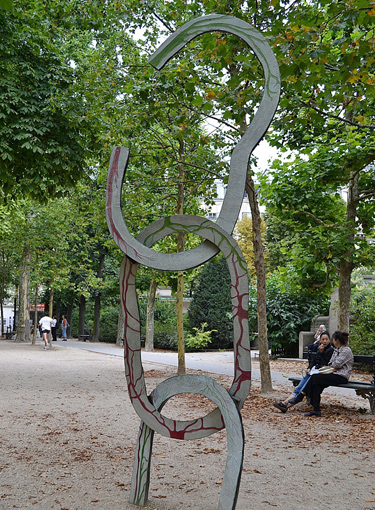Artist:
Fabrice Hyber
Title:
Le Cri, l'Ecrit
Year:
2007
Adress:
Jardin du Luxembourg
www.laparisienneetsesphotos.eklablog.com:
Le Cri, l'ecrit est une oeuvre de l'artiste français Fabrice Hyber. Il s'agit d'une sculpture en bronze symbolisant l'esclavage et son abolition. Creee en 2007, elle est installee dans leJardin du Luxembourg a Paris, en France
L'oeuvre est une sculpture monumentale en bronze polychrome de 3,70 m de hauteur1. Elle est constituee de trois elements en forme d'anneaux, assembles l'un a l'autre pour former une chaîne. L'anneau inferieur semble a moitie enfoui sous le sol ; le deuxieme forme un ovale complet et ferme ; le dernier represente un anneau brise sur l'un de ses cote.
L'oeuvre possede deux faces: l'une de ces faces est bombee et peinte de couleur sombre. L'autre est plate et parcourue de nervures rouges et vertes sur un fond blanc. Cette derniere comporte egalement des mots inscrits en relief sur sa surface, qui portent sur la thematique de l'esclavage.
Une plaque situe a quelque distance de l'oeuvre explique la symbolique de l'oeuvre : l'anneau inferieur symbole les racines, celui du milieu la possibilite toujours actuelle de l'esclavage, celui du haut, ouvert, son abolition. La plaque porte egalement le nom de l'oeuvre et de l'artiste, la date de sa creation et les circonstances de son inauguration. Sur son revers, la plaque mentionne plusieurs dates marquant l'abolition et la commemoration de l'esclavage en France, precedee d'un extrait de Cahier d'un retour au pays natal d'Aime Cesaire.
Translation
www.laparisienneetsesphotos.eklablog.com:
The Scream, the Scripture is a work of French artist Fabrice Hyber. It is a bronze sculpture symbolizing slavery and its abolition. Created in 2007, it is installed in Luxembourg Le Jardin in Paris, France.
The work is a monumental sculpture in polychrome bronze 3.70 m hauteur. It consists of three ring-shaped elements, assembled to each other to form a chain. The lower ring appears half buried in the ground; the second forms a complete and closed oval; the latter represents a split ring on one of its side.
The work has two faces: one of these faces is curved and painted dark. The other is flat and covered with red and green veins on a white background. The latter also includes words written in relief on its surface, which deal with the theme of slavery.
A plaque located at some distance from the work explains the symbolism of the work: the lower the roots symbol ring, the middle the ever present possibility of slavery, the top one, opened its abolition. The plate also carries the name of the work and the artist, the date of its creation and the circumstances of his inauguration. On its reverse, the plaque mentions several dates marking the commemoration and the abolition of slavery in France, preceded by an excerpt from Cahier d'un retour au pays natal Aime Cesaire.
Le Cri, l'ecrit est une oeuvre de l'artiste français Fabrice Hyber. Il s'agit d'une sculpture en bronze symbolisant l'esclavage et son abolition. Creee en 2007, elle est installee dans leJardin du Luxembourg a Paris, en France
L'oeuvre est une sculpture monumentale en bronze polychrome de 3,70 m de hauteur1. Elle est constituee de trois elements en forme d'anneaux, assembles l'un a l'autre pour former une chaîne. L'anneau inferieur semble a moitie enfoui sous le sol ; le deuxieme forme un ovale complet et ferme ; le dernier represente un anneau brise sur l'un de ses cote.
L'oeuvre possede deux faces: l'une de ces faces est bombee et peinte de couleur sombre. L'autre est plate et parcourue de nervures rouges et vertes sur un fond blanc. Cette derniere comporte egalement des mots inscrits en relief sur sa surface, qui portent sur la thematique de l'esclavage.
Une plaque situe a quelque distance de l'oeuvre explique la symbolique de l'oeuvre : l'anneau inferieur symbole les racines, celui du milieu la possibilite toujours actuelle de l'esclavage, celui du haut, ouvert, son abolition. La plaque porte egalement le nom de l'oeuvre et de l'artiste, la date de sa creation et les circonstances de son inauguration. Sur son revers, la plaque mentionne plusieurs dates marquant l'abolition et la commemoration de l'esclavage en France, precedee d'un extrait de Cahier d'un retour au pays natal d'Aime Cesaire.
Translation
www.laparisienneetsesphotos.eklablog.com:
The Scream, the Scripture is a work of French artist Fabrice Hyber. It is a bronze sculpture symbolizing slavery and its abolition. Created in 2007, it is installed in Luxembourg Le Jardin in Paris, France.
The work is a monumental sculpture in polychrome bronze 3.70 m hauteur. It consists of three ring-shaped elements, assembled to each other to form a chain. The lower ring appears half buried in the ground; the second forms a complete and closed oval; the latter represents a split ring on one of its side.
The work has two faces: one of these faces is curved and painted dark. The other is flat and covered with red and green veins on a white background. The latter also includes words written in relief on its surface, which deal with the theme of slavery.
A plaque located at some distance from the work explains the symbolism of the work: the lower the roots symbol ring, the middle the ever present possibility of slavery, the top one, opened its abolition. The plate also carries the name of the work and the artist, the date of its creation and the circumstances of his inauguration. On its reverse, the plaque mentions several dates marking the commemoration and the abolition of slavery in France, preceded by an excerpt from Cahier d'un retour au pays natal Aime Cesaire.



